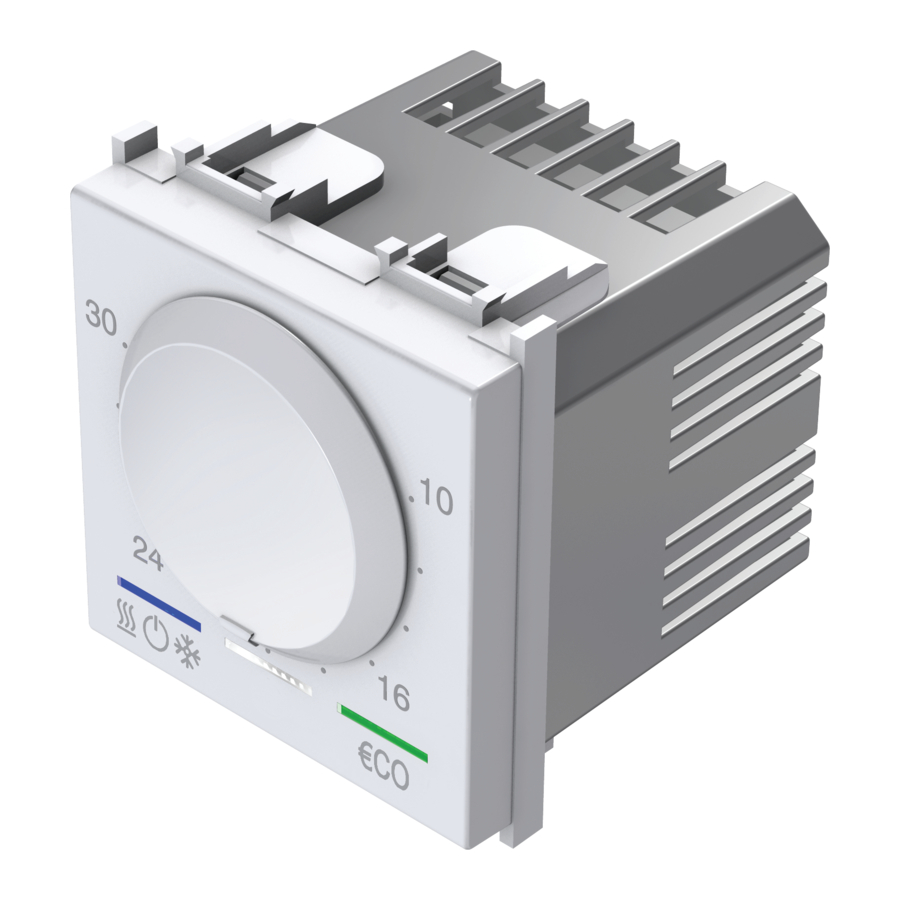
Advertisement

Description

The thermostat is intended for temperature regulation in a room and enables two modes of operation – heating and cooling. It has several functions installed for the economic use of energy:
- an ECO function for operation with a lowered or energy-saving temperature
- an adaptive ECO function for automated daily operation with a lowered or energy-saving temperature
- a safety function for protection against freezing
- a safety function for protection against overheating
The operation is indicated via LED lights. Thermostat setup is performed with the help of a rotary button for setting the temperature and with touch buttons.
Technical specifications
- electronic thermostat, basic
- operation mode: heating / cooling / turn off
- power supply: 230 VAC, 50 Hz
- energy consumption: max 0.4 VA
- output: 6(2) A, 230 VAC, relay switch, potential-free
- method of regulation: ON/OFF
- voltage pulse: 2.5 kV
- regulation range: +10°C do +30°C
- hysteresis: ±0.5°C, ED: 20 minutes
- anti-freeze protection (heating mode): +6°C
- overheating protection (cooling mode): +32°C
- ECO function for lowering the temperature by 3°C for 6 hours in heating mode and raising the temperature by 3°C for 6 hours in cooling mode
- Adaptive ECO function: automatically lowers the temperature by 3°C for 6 hours in heating mode and raises the temperature by 3°C for 6 hours in cooling mode every day at the same time
- option to turn on ECO operating mode with an external trigger via a separate input
- LED indication of operation
- IP protection class: IP20, indoor use only
- number of automatic cycles: 100,000
- not suitable for electrical floor heating
- screw contacts max. 2.5 mm
- in accordance with the LV Directive, the EMC Directive, standards EN60730-1 and EN60730-2-9
- operating temperature: 5 ÷ 35°C
- storage temperature: -20 ÷ 50°C
Installation


The thermostat must be installed using the mounting frame and cover plate from the TEM Modul family.
For the thermostat dimensions and method of installation, see (3a), (4.).
When the power to the thermostat is switched on, the thermostat powers up and performs a self-diagnostic test. It needs several seconds to enter standby mode. During the process, the LED lights on the thermostat blink alternately.
If the power to the thermostat is interrupted, the thermostat reverts to the mode of operation it was in before the power interruption. If the Adaptive ECO function was activated, the function is turned off and has to be re-activated at the desired time.
Warnings regarding installation
The mounting location should be on an interior wall, approximately 1.5 m above floor level. To ensure correct operation, we recommend mounting the thermostat in its own separate box, away from any heat sources or drafts of air.
Connection



The installation and connection should only be performed by persons with suitable expert training. The connection has to be performed in accordance with the valid regulations.
The electrical connection of the thermostat is to be executed according to the connection diagram (5a, 5b or 5c):
(5a) circulation pump, burner (direct connection), thermoelectric drive
(5b) boiler, heat pump, burner (control input T1/T2)
(5c) motor drive (limited use with underfloor heating)
Electrical Connection of the Energy Saving Pumps
If the electronic pump does not have an automatic limitation of the starting current (which is up to 50 times higher than the rated current when the pump is turned on) or in the event of a pump with a higher power, it is necessary to use a power relay or a contactor to switch the pump on!
Use of the electronic thermostat

(6a.)
Using the rotary button, set the desired temperature to between 10°C and 30°C.
Safety functions:
- anti-freeze protection (heating mode); set the button to minimum
- overheating protection (cooling mode); set the button to maximum
(6b.)
The thermostat is toggled on and off with a short tap (~1 s).
A 5 second touch toggles between heating and cooling. A red light indicates that the active mode of operation is heating; if the active mode of operation is cooling, this is indicated by a blue light.
(6c.)
A white light indicates the state of the control output. The light is lit if the output is active.
(6d.)
ECO mode is activated with a short tap (~1 s). An active ECO mode is indicated by a green light. For the next 6 hours, the temperature will be 3°C lower (in heating mode) or 3°C higher (cooling mode) than the set temperature. After 6 hours, ECO mode is automatically deactivated and day temperature operation is resumed. When day temperature operation is active, none of the lights are lit.
Adaptive ECO mode is activated by a 5 second touch. If Adaptive ECO mode is activated, this is indicated by a continuous green light and short blinks of the orange light. For the next 6 hours, the temperature will be 3°C lower (in heating mode) or 3°C higher (cooling mode) than the set temperature. After 6 hours, Adaptive ECO mode is automatically deactivated and day temperature operation is resumed. Day temperature operation in Adaptive ECO mode is indicated by the orange light. The Adaptive ECO mode automatically repeats every day, at the same time that it was initially activated. The Adaptive ECO mode can be deactivated at any time by a 5 second touch of the ECO button.

Documents / Resources
References
Download manual
Here you can download full pdf version of manual, it may contain additional safety instructions, warranty information, FCC rules, etc.
Advertisement

Need help?
Do you have a question about the EM37 and is the answer not in the manual?
Questions and answers